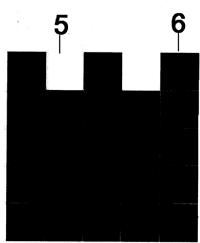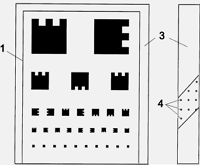VISUAL HEALTH ANALYSIS DEVICE
|
Description |

Figure 1. Mesh that includes blank holes (5) and black squares (6) to complete the E of Coriant
It is a device for the measurement of visual acuity (VA) that includes new optotypes (ocular vision tables) traced in a mesh of 5 by 5 frames of equal size, where 2 of the 25 frames are transparent or white while the The rest of the boxes are black, so that the silhouette of a letter E (called E de Coriant) is produced. There is the possibility of varying the contrast of the optotypes used by varying the background color.
|
How does it work |
Figure 2. Frontal and lateral vision. Optotype scale (1), Coriant E (2), Frame (3), colored LEDs (4).
Visual acuity (VA) is the physiological ability to discriminate two separate points by a third located right in the middle. The greater its value, the greater the capacity of the eye to perceive smaller objects. The determination of VA is a practice of great importance both in medicine and in other disciplines of life in which it is required to accredit a certain minimum visual capacity.
In Optometry, to measure visual acuity, which is improved by correcting the ametropia that reduces it using ophthalmic lenses, contact lenses or refractive surgery, scales of optotypes (figures or symbols) specifically developed for this measure are used.
The sizes of the optotypes go from highest to lowest along the scale for the evaluation of VA with any eye. The measures that these optotypes make allow knowing the limit of the vision of each person.
|
Advantages |
It provides more accurate AV measurements and less dependent on factors other than the possible visual alterations of individuals: Cataracts, maculopathies, retinitis pigmentosa, poorly compensated diabetes, dry eye, ulcers, etc.
|
Where has it been developed? |
This invention has been developed in the Faculty of Optics and Optometry and is protected by national invention patent since 2015 This group of inventors has generated more than 20 patents.
|
Contact |
|
© Office for the Transfer of Research Results – UCM |
|
PDF Downloads |
|
Classification |
|
Responsible Researcher |
Ricardo Bernárdez Vilaboa: rbvoptom@ucm.es
Department: Optometry and Vision
Faculty: Optics and Optometry



